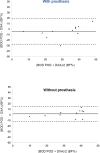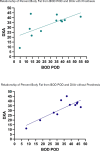Comparison of Body Composition Methods for Estimating Body Fat Percentage in Lower Limb Prosthesis Users
- PMID: 38873009
- PMCID: PMC11168604
- DOI: 10.33137/cpoj.v6i1.41605
Comparison of Body Composition Methods for Estimating Body Fat Percentage in Lower Limb Prosthesis Users
Abstract
Background: There is a dearth of literature evaluating the accuracy of Air Displacement Plethysmography (ADP) compared to Dual-energy X-ray Absorptiometry (DXA) for assessing body composition in individuals with lower limb amputations. Validity of ADP in persons with lower limb amputations must be established.
Objective: The objective of this study was to compare body composition in persons with lower limb amputations using the BOD POD® and DXA.
Methodology: Body composition was performed on eleven lower limb prosthesis users (age 53.2±14.3 years, weight 81.9±22.3kg) using ADP and DXA with and without prosthesis.
Findings: Repeated measures ANOVA indicated no significant difference in body composition among and between trials, F(3,8)= 3.36, p= 0.075. There were no significant differences in Body Fat (BF) percentage with and without prostheses on the BOD POD (28.5±15.7% and 33.7±12.1%, respectively) nor the DXA (32.9±10.6% and 32.0±9.9%, respectively). Association between the BOD POD and DXA were greatest when prostheses were not worn compared to when they were worn. Bland-Altman plots indicate agreement between BOD POD® and DXA was greatest while wearing the prosthesis.
Conclusion: This study is a first to compare total body fat percent between the BOD POD® and DXA in lower limb prosthesis users. BOD POD® report valid indices of BF%. Future work will utilize the BOD POD® in intervention studies for monitoring body composition changes across the continuum of rehabilitation.
Keywords: ADP; Air Displacement Plethysmography; Amputation; Body Composition; Body Fat; DXA; Dual-Energy X-Ray Absorptiometry; Prosthesis.
Copyright (c) 2023 Smith JD, Guerra G, Symons TB, Kwon EH, Yoon EJ.
Conflict of interest statement
The authors declare no financial and personal relationships with organizations or individuals that might have influenced their research.
Figures



Similar articles
-
Air displacement plethysmography versus dual-energy x-ray absorptiometry in underweight, normal-weight, and overweight/obese individuals.PLoS One. 2015 Jan 21;10(1):e0115086. doi: 10.1371/journal.pone.0115086. eCollection 2015. PLoS One. 2015. PMID: 25607661 Free PMC article. Clinical Trial.
-
Agreement Between 2 Segmental Bioimpedance Devices, BOD POD, and DXA in Obese Adults.J Clin Densitom. 2020 Jan-Mar;23(1):138-148. doi: 10.1016/j.jocd.2019.04.005. Epub 2019 Apr 27. J Clin Densitom. 2020. PMID: 31122829
-
Evaluation of the BOD POD for estimating percent body fat in collegiate track and field female athletes: a comparison of four methods.J Strength Cond Res. 2008 Nov;22(6):1985-91. doi: 10.1519/JSC.0b013e318185f196. J Strength Cond Res. 2008. PMID: 18978611
-
Body-composition assessment via air-displacement plethysmography in adults and children: a review.Am J Clin Nutr. 2002 Mar;75(3):453-67. doi: 10.1093/ajcn/75.3.453. Am J Clin Nutr. 2002. PMID: 11864850 Review.
-
Comparing digital anthropometrics from mobile applications to reference methods: a scoping review.Eur J Clin Nutr. 2025 Apr 7. doi: 10.1038/s41430-025-01613-1. Online ahead of print. Eur J Clin Nutr. 2025. PMID: 40195526 Review.
References
-
- Hales CM, Carroll MD, Fryar CD, Ogden CL.. Prevalence of Obesity and Severe Obesity Among Adults: United States, 2017–2018. NCHS Data Brief. 2020; 360:1–8. PMID: 32487284 - PubMed
LinkOut - more resources
Full Text Sources
Miscellaneous
